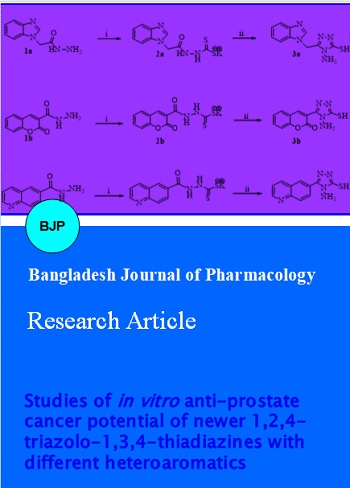Studies of in vitro anti-prostate cancer potential of newer 1,2,4-triazolo-1,3,4-thiadiazines with different heteroaromatics
DOI:
https://doi.org/10.3329/bjp.v10i2.22424Keywords:
Anti-cancer, Coumarin, Heterocycles, Prostate cancerAbstract
This study was aimed to evaluate anticancer potential of newer synthesize 1,2,4-triazolo[3,4-b]-1,3,4-thiadiazines and its derivatives. All newly furnished scaffolds were subjected to screening for their in vitro anticancer potential against DU-145 and PC-3 prostate cancer cell lines using SRB and MMT bioassays. The structures of final compounds were confirmed with the aid of FT-IR, 1H NMR, 13C NMR spectroscopy and CHN analysis. Bioassay studies suggested that all thiadiazines were promising cytotoxic agents with % cytotoxicity ranging from 44.39-71.24%, whereas potent GI50 level in the range 11.96-32.51 µg/mL and results were comparable to the potencies of control drugs adriamycin and doxorubicin. Variation of heterocyclic pharmacophores along with the C-5 position of 1,2,4-triazole in terms of quinoline, quinazoline, coumarin and pyridine lead to the different SAR predictions in which quinoline and benzimidazole moieties found most promising.
Downloads
546
443 Read
190

Additional Files
Published
How to Cite
Issue
Section
License
Authors who publish with this journal agree to the following terms:
- Authors retain copyright and grant the journal right of first publication with the work simultaneously licensed under a Creative Commons Attribution License that allows others to share the work with an acknowledgement of the work's authorship and initial publication in this journal.
- Authors are able to enter into separate, additional contractual arrangements for the non-exclusive distribution of the journal's published version of the work (e.g., post it to an institutional repository or publish it in a book), with an acknowledgement of its initial publication in this journal.
- Authors are permitted and encouraged to post their work online (e.g., in institutional repositories or on their website) prior to and during the submission process, as it can lead to productive exchanges, as well as earlier and greater citation of published work (See The Effect of Open Access).
